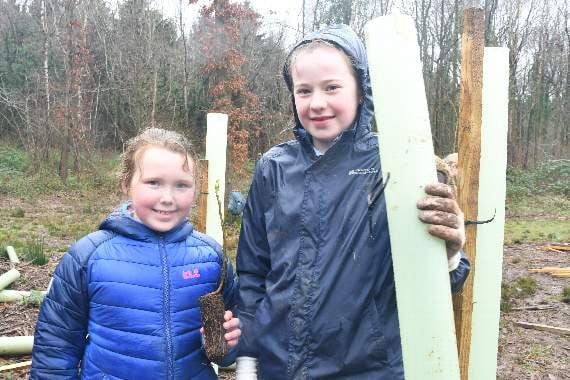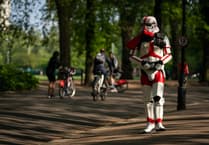IT is a truth universally acknowledged that trees can save the world. Plant enough of them and they will ‘fix’ the carbon in the atmosphere that is contributing to climate change.
Is it really that simple? Not quite, according to Deputy Surveyor of the Forest, Kevin Stannard.
While Mr Stannard and Forestry England are keen on planting trees, they say it has to be the right tree in the right place and for the right reason – like those rare service trees being planted at Dymock.
Speaking at a forum of environmental campaigners after local schoolchildren had planted 100 service trees in the Centenary Glade in Dymock Woods on Friday (February 28). he said: “Everyone is planting trees. We have this fantastic mission to plant trees.
He said that in a mature forest 17 per cent of the carbon is locked in the above ground biomass, there is about five per cent in the litter layer and about six per cent in the root system.
“That is 28 per cent the rest is in the soil and that works for pretty much every eco system – most of that carbon is locked there so what we do with our soils going forward is of fundamental and critical importance.
“But if you work out how much forest carbon there is in the UK, its about 620 million tonnes. How much carbon we are losing as a country? 508m tonnes.
“We can plant up the entire country over the next two years to save our carbon emissions this year and next. What are you going to do in year three?”
“Trees can save the world but fundamentally they are not the answer, behaviour change is the answer.
“You can go so far but we have to cut emissions.”
But he said that it was not “pointless” to plant trees to mitigate climate change.
He said: “They have a fundamental role in mitigating the extremes of climate change.
“The landscape structure – storm water flows, refuge for wildlife, groundwater management, temperature and shading, air and water quality and soil protection
“Taking carbon out of the atmosphere is great but the landscape role of trees over the longer term is going to be more fundamentally important than fixing carbon.
“The way to sort carbon in the atmosphere is to stop putting it in there in the first place.
“The key is to get society to understand that working with nature is a way to us to evolve more sustainably as the climate changes.”
The range of species being planted in the Forest of Dean is also being widened in response to future changes in climate.
Mr Stannard said: “We are planting 10 to15 species this year –over the last 30 years the Forestry Commission has probably had four stable species
“Now we are looking to expand to between 10 and 15 because we are looking extend that pallet to give the structure of the forest the best chance of surviving going forward.”
Forestry England collected 15 tonnes of acorns from Dymock Woods but, perhaps surprisingly, they are shipped out of the area.
Mr Stannard explained: “if you are planting oak in the forest of dean they currrently come from France because we need to get the genetic diversity.”
But it not only Forestry England who are looking to plant trees and as more of us look to do our bit, supplies of seeds and saplings.
He said: “To meet the demands of everyone who wants to plant trees, there has to be an upscaling of nursery capacity.
“The international seed industry cannot keep up with the ‘Greta effect’.
“I would advocate community seed nurseries for the type of community action we need to get going at grass roots. “What is important is that everyone, this community, the Forest of Dean, Great Britain is doing something positive, connecting everyone with our natural environment, sharing our understanding of our natural landscapes and built environment.
“There is no need to let go of those aspects of our landscape which are culturally important or naturally important, we just need to be thinking about them differently.
“By caring about woods, wildlife and people today we need to think about what will be different to give the next generation the best chance of enjoying those different landscapes.
“Species might be different but the cultural and natural values will not be different.
We need to give nature space to evolve. If you can bring in a species of tree from further south I would recommend you do but it comes back to the objectives.
“If it is to maintain the landscape structure then we need as many tree species as possible but if it is to continue the oak, field maple and wild service nature of Dymock Woods then you are limited.”
Mr Stannard also urged anyone buying trees at a nursery or garden centre to ensure the specimen was grown in Britain.
“We do not want imported trees because that is spreading disease.
“By caring about woods, wildlife and people today and thinking about what will be different, we will give the next generation the best chance of enjoying those different landscapes.”





Comments
This article has no comments yet. Be the first to leave a comment.